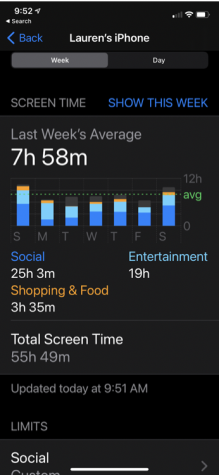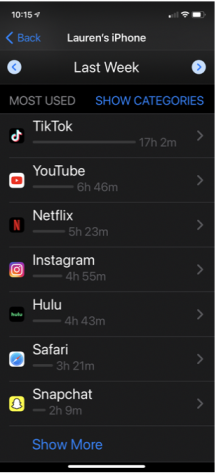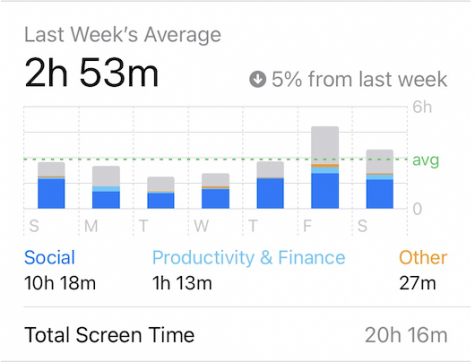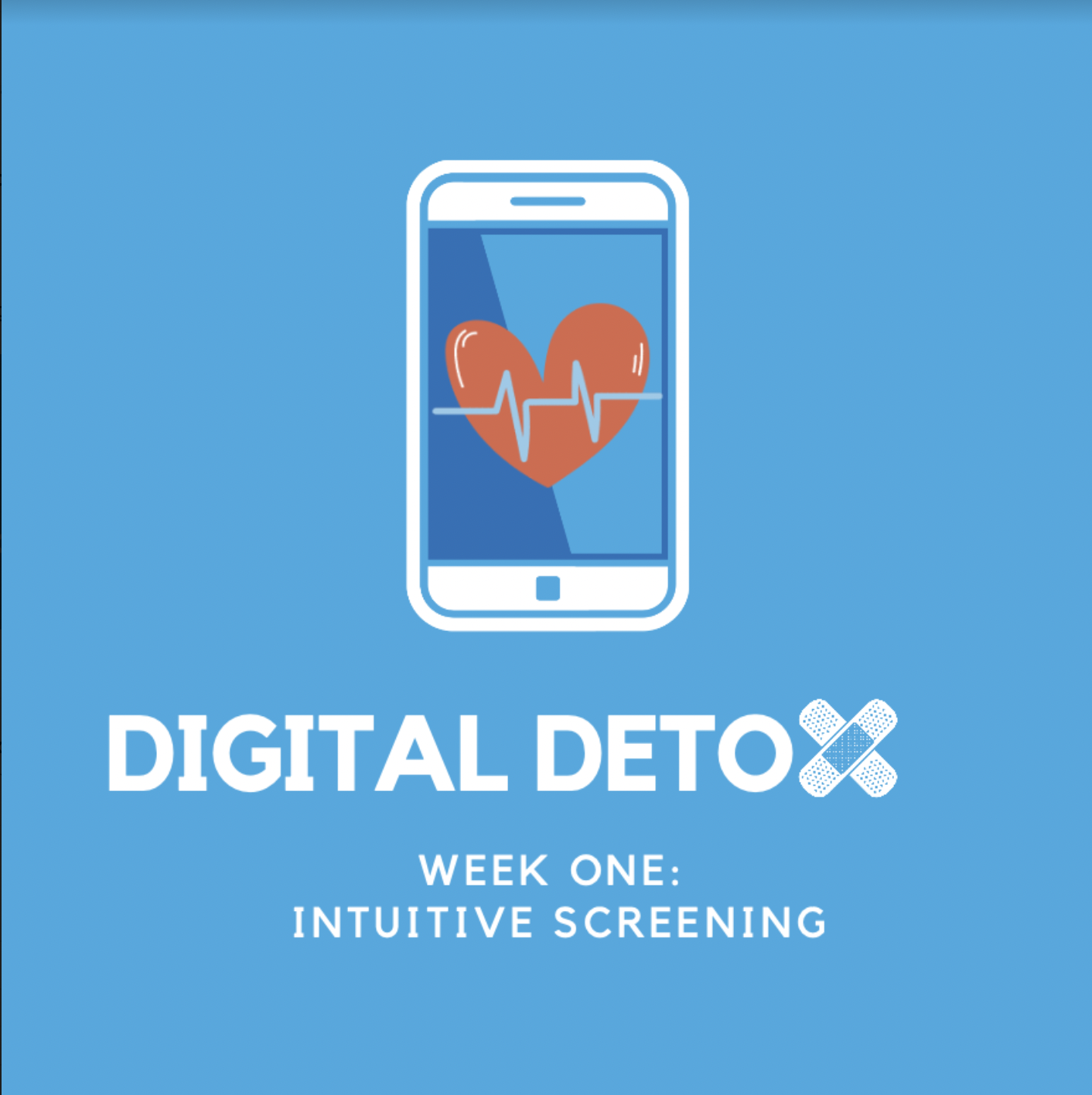Nora: Digital Detox
In this day and age, the average teenager’s life revolves around one thing, their phone. Many of us vow to “spend less time online” and sometimes we go as far as to say “I need to get rid of social media ”. Now these statements may sound like they are heading in the right direction, I mean at least us “screenagers” know there is an issue, but I’m afraid it’s not that simple. Our generation is addicted, trading in tobacco for tech. Each vow of lowering screen time turns into a digital binge, in which your phone is glued to your side for a solid 24 hours. We panic when they are lost and throw a fit when they die. I don’t need to go in depth about what we’ll do for our phones, everyone knows what I’m talking about.
When you look up “How to lower screen time” on Google over 6,500,000,000 results pop up. When sifting through advice, some options seem a little bizarre (buzzfeed do we really need to make bathrooms tech free zones?). I have gone through and picked some of the more promising tactics, and will be partaking in “tech rehab”. I will, hopefully, debunking some screen time myths and, in the process, hopefully learning some tricks that actually work.
Week One: Intuitive Screening
To start this journey off, we are treading lightly with intuitive screaming or, in other words, seeing how bad the problem is. This  past week, I tried to be more mindful about how much time I spend on my phone. According to Carrie James, a sociologist at Harvard, the three steps to being more mindful about screen time (or conscious connectivity as she calls it) are reflecting on responsibilities, thinking through dilemmas, and envisioning action steps. If you look at the photo of my weekly screen time recap, you can see how well this worked for me – whoopsie.
past week, I tried to be more mindful about how much time I spend on my phone. According to Carrie James, a sociologist at Harvard, the three steps to being more mindful about screen time (or conscious connectivity as she calls it) are reflecting on responsibilities, thinking through dilemmas, and envisioning action steps. If you look at the photo of my weekly screen time recap, you can see how well this worked for me – whoopsie.
OK, so I admit this wasn’t my best week. James’ three vague tips clearly did very little in terms of motivating myself to make more mindful decisions when it came to screen time. A new warning from the AHA warns that kids aged 8-18 should spend just two hours a day on their phone. My whopping average of about eight hours a day exceeds that by over five hours a day, or almost 56 hours in a week. This meant I spent 33.33% percent of my week on my phone. 
When looking at where all of my precious time seems to be going, just over 25 hours a week were spent on social media, making it by far the most used category. It is then followed by 19 hours of entertainment (if you are watching Only Murders in the Building on Hulu, you understand why this number is so high). And then finally, my recipe hunting and online shopping addiction were exposed, taking the number three spot for this week’s screen time.
This week, I learned my personal willpower alone isn’t going to cut it. Next week, I’m going to take matters out of my own hands and let the professionals start to dictate my screen time. Wish me luck, and please don’t snap at me. I’m kind of on a detox.
Week Two
According to research published by the Journal of Social and Clinical Psychology, spending only 30 minutes a day on social media can result in “significant improvement and wellbeing” from reduced anxiety to feeling less lonely. When reading this, I immediately compared it to my screen time where I racked in a whopping four hours a day or 28 hours a week on social media alone. I got a little concerned by this huge difference , but it turns out I’m not alone in my battle keeping my phone down. Common Sense Media found that teengagers spend one-third, or nine hours, of their day using some sort of media on their phone.
There is no doubt we are hooked. On Sunday night, I set myself some limits: 30 minutes of social media Monday through Friday. Monday morning, my normal alarm went off and I picked up my phone. I scrolled for a little bit and then made my way out of bed. You can imagine my shock when I got to the first period and tried to go on Snapchat, only to realize I was completely out of all social media time for the day. It was eight in the morning. This frustrating awakening led me to ration out my seconds on my social media . No moment went wasted as I restricted my phone time in a bit of an overly obsessive manner all day Tuesday. This yoyo approach led to acceptance by Wednesday, when I didn’t run out of time until around five. I’m not going to lie, I was a little bored, but no major complaints. Thursday and Friday were perfect for getting me into the Halloween weekend considering I spent the entirety of my time at school stalking my friends to hear about every detail of our Halloween planning that I was missing in the groupchat.
Losing unlimited access to social media was definitely a challenge, but the upsides to ditching my old ways were already apparent two weeks into this experiment. With no scrolling on TikTok until midnight, I really had nothing else to do besides school work. In my three years of highschool, I had never been more ahead than during this week. I was a week ahead in half of my classes, which for me, and my specialty in procrastination, is unheard of. I won’t deny that by Saturday morning I was more than eager to lay in bed and take my time scrolling through my dearly missed social media, but the good week behind me definitely motivated me through the challenge of next week.
Week Three
The weekend after week two, one could say I binged on social media the following weekend. Technically, I didn’t break any rules considering my detox only lasted from Monday to Friday. But something about my excessive screen time the past weekend left me feeling kind of gross and out of it. Although four hours a day over the weekend was still much lower than my starting time of eight hours everyday, I could feel a negative difference in my day when I spent a majority of it on my phone. This realization made me, dare I say, excited for the week to come. lf you had told me a month before I would be excited to give up all social media for a week, I would have laughed in your face.
On Sunday night, just before I went to bed, I deleted all of my social media apps off my phone. This means TikTok, Snapchat, Instagram, even Youtube and Pinterest. Opening my phone on Monday morning to find absolutely nothing was a shock, even though I deleted the apps myself. I usually allot myself a minimum of 15 minutes in the morning to go on TikTok, maybe Instagram, and turn on a video to watch while I get ready for school. This was obviously not an option, and all I could do was get ready for school. After I got ready for school, a record thirty minutes earlier than usual, I had time to eat breakfast, make my bed, and even give my room a quick clean. This trend continued throughout the entire week, and honestly I have no complaints. The complete lack of stress that came with technology-free mornings was so much better than any video I could watch in the morning.
My new abundance of time followed me when I got home from school. After I come home from the gym, I usually take a shower, lay in bed and scroll until I’m snapped out of my phone coma for dinner. Once again, this normal practice of mine was totally off the table. I ended up doing my homework, cleaning my room, writing out my week in my planner all before dinner, and I found myself so bored after dinner that I actually went onto Schoology and did my homework for the next day before going to bed at 9 p.m. That’s right I went to bed at 9 p.m., which is the first time I have gone to bed in the single digits since middle school.
Walking into this week’s challenge, I was terrified that I would be absolutely miserable, but this week also turned out to be my absolute favorite week of all. It was definitely not all easy. There were times I just wanted to talk to my friends and found the complete lack of social media was a little isolating. But day-to-day life had never been better. I was sleeping better (and longer), my grades had literally never been better, and overall, I felt happier (as cliche as that may sound). I realized on Saturday, when I got social media back, how much more present I was with-out it. When you’re never thinking about your phone, you are forced to be totally immersed in what’s happening in front of you, which was my favorite takeaway from this final week.
What I learned
Walking into my digital detox, the best outcome I could think of was lowering my screen time and maybe being more productive. At the end of this, I learned that by separating my phone from my day-to-day schedule, the way I ran my life could take a completely positive shift. These past three weeks have been incredibly eye opening, and I would honestly recommend taking a look at your screen habits if you feel like you lack structure in your day-to-day life. My biggest/easiest tips that you can implement into your everyday life would be setting limits for yourself! It’s easy to pick up your phone to respond to a random text, only to find yourself getting bored on TikTok an hour and a half later. By setting limits for certain apps, you simply get a limit that is perfect for snapping you out of your phone coma. Turning off my notifications was also a huge help because once you remove them, your phone loses almost all of its temptation. There are no pesky little buzzers popping into your home screen, showing you everything you think you’re missing. You may hear my recommendations and think I sound like your mom telling you to get off your phone, but as a girl who loves her phone just as much as you do and knows what it’s like to have your whole life revolve around it, please, for the love of God, put your phone down. It made a huge difference in my life, and I plan on taking what I learned and implementing it into my everyday life even post-detox.
Charlotte: Digital Detox
 Seven hours a day. 49 hours a week. 210 hours a month. 2520 hours a year. Put most shockingly perhaps, 105 days a year.
Seven hours a day. 49 hours a week. 210 hours a month. 2520 hours a year. Put most shockingly perhaps, 105 days a year.
According to a report from Common Sense Media, teenagers spend an average of seven hours and 22 minutes on their phones each day, excluding time spent on schoolwork.
When I first saw this figure, I was disgusted, for lack of a better term. Now more than ever, with college applications looming, I feel like I never have enough time. So learning that I might spend almost a third of my day mindlessly scrolling through my phone was startling, to say the least.
Eventually, I mustered up the courage to check my own screen time report. I was still mildly disgusted, but slightly relieved, to see two hours and 53 minutes stare back at me.
Enlightened by this knowledge, I began seeking out ways to regain control of those lost minutes and after exchanging stories with Nora, the digital detox began. Following Nora’s lead, I also attempted to apply James’ three steps for “conscious connectivity.”
Week One: Intuitive Screening
Step One: Reflecting on Responsibilities
This stage involved reflecting upon why we as users feel the need to continuously check our phones.
I realized that for me, my nasty habit of compulsively checking my phone every five minutes was rooted in a fear of missing important messages, or being uninformed about the world around me.
Though I initially check my phone for messaging and news/information purposes to lull those fears, I often find myself becoming sidetracked, which eventually ends in mindless scrolling and creates a vicious cycle of lost time.
After recognizing this, I determined that in my digital detox, I would primarily target my social media usage. This would leave my primary uses for my phone, messaging and news/information, available while eliminating or, at the very least, reducing the distractions.
Step Two: Thinking through Dilemmas
Now that I had a focus, I needed to break it down.
As displayed in my screen time report, the majority of my screen time hours for the week consisted of social media platforms Snapchat and Instagram. The rest of my screen time was attributed with more random, non-social media apps that included everything from an hour spent on healthline.com to, don’t ask me how, almost 25 minutes on Apple’s clock app.
Regardless, Instagram and Snapchat still contributed the most minutes to my screen time by far, making them my primary targets.
Step Three: Envisioning Action Steps
With the targets in place, my next step was to create an action plan that would strategically reduce the attraction of each of my common distractions or, in the likely event that this method failed, restrict their accessibility.
In week two, I will be setting screen time limits on Snapchat and Instagram with a maximum of 45 minutes on Snapchat and 15 minutes on Instagram.
With battle plans laid out, I’m prepared to face and resist any distraction that might come my way in week two… at least I hope. Same time next week?
Week Two
I’ll admit that I have actually already had limits on my screen time for a few months before this. They were less restrictive than the ones I set in place this week, but they had definitely already cut back my screen time significantly from what it was about a year ago. Still, I wanted to cut that number down even more, as even wasting two to three hours each day on my phone seems like way too much.
The biggest change I saw this week was in my mindset while using social media.
Because my week one screen time was already a reduction from what it once was, I wasn’t expecting massive change this week since I only lowered the limits slightly. The change that I did see this week though was in how that time was spent.
For the first few days, I found myself trying to strategize how my time was spent, using my social media apps for shorter amounts of time but almost more often than before. It wasn’t until Wednesday that I decided to fully embrace the challenge and lean out of the urge to constantly check my social media apps and become more present in my real life.
For me, becoming more present in my real life meant instead of checking in with friends on social media, I spent more time with them in person or took the time to call them and have live conversations. Although these live conversations increased my screen time and I was still technically on my phone, the time felt much more constructive and meaningful than the quick text exchanges that they replaced.
Not only were my conversations more productive this week, but I also found myself being more productive overall as well. By spending less time mindlessly clicking and scrolling, I was able to redirect my focus and effort into my school work.
I was much more on top of my assignments this week, which freed up time in other areas of my life too. Essentially, there was an almost domino effect on time in my life.
This week, my screen time decreased to two hours 32 minutes from my initial two hours 50 minutes. It was a notable decrease, but after seeing the positive impact that setting just a few limits made in my life, I want to take this goal towards “conscious connectivity” a step farther.
Week Three
After reflecting on week two, I decided that maybe how much time I was spending on my phone wasn’t actually as important as how that time was spent. With that in mind, I decided to delete social media apps off of my phone.
We’ve all heard the saying “you never know what you’ve got until it’s gone.” It sounds dramatic, but this week it was true.
After deleting all of my social media apps, I found myself forgetting I had done it and frequently caught myself almost clicking the blank spaces where my apps used to be. It wasn’t so much that I missed my social media as that only then did I realize how bad of a habit checking it had become.
Most of the time when I found myself reaching for my social media apps, I wasn’t even all that interested in what they contained, but it was almost as though I was conditioned to compulsively check in.
Without social media, I felt a little disconnected at first. I wasn’t actually missing any news or meaningful information from social media, but the idea that I might be was what I felt most dramatically.
In realizing this, I came to understand why social media has the power it does. During this week, I had conversations with a few people who noticed my absence. In each one, the person I was talking to expressed admiration for what I was doing, noting that they wished they could do the same.
But the thing is, every single one of them could. They were all faced with the same decision I was at the start of each day this week. The only difference was that they made the conscious decision to engage with the social media that I was choosing to disconnect from. But maybe it wasn’t such a conscious decision for them.
When I made this point, I was always met with either an “Oh yeah, I guess you’re right” or “Oh, but I could never.”
For the first type of response, there was always a pause before it. It was almost as though they had never considered that engaging with social media is a choice not a requirement.
For the latter response, none paused before speaking. Their responses were almost immediate, as if my suggesting it to begin with was illogical. I was taken aback by those responses, as it revealed the scope of just how dependent we have become on social media.
No matter the response, every person I talked to led me to the same conclusion. Social media has become the dominant force that it has not because of any particularly alluring content but rather because it offers connection.
Never once this week did I find myself missing the actual content of my social media but instead found myself feeling disconnected to my peers around me. Social media’s addictive nature stems from a human desire to feel as though we are a part of something, and when that connection is broken, we feel withdrawal symptoms from the social network that we now, unfortunately, rely on to connect us with each other.
Ultimately, though I started this “detox” hoping to reduce my screen time overall, I came to learn that how I was spending this screen time was actually a larger threat than the quantity of time. After becoming aware of my own dependence on social media through this detox, I will likely never look at social media the same way again nor return to using it like I did before.
Even if you would never consider doing Nora and I’s digital detox on your own, I hope that you will be more conscious of your own social media usage and, if you find that you have one, overcome the addiction.
